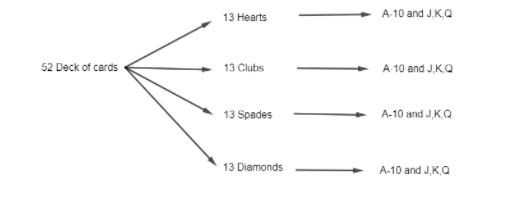
When three cards are drawn from a standard 52-deck, What is the Probability they are all the same rank? (For example, all three are kings).
Answer
492.6k+ views
Hint: In order to answer this question, we must first understand the layout of a 52-card deck. The deck is divided into four suits, each with 13 cards. Hearts, diamonds, spades, and clubs are the four suits. A(ace), 2 to 10 cards and 3 face cards (Queen, King, and Jack) make up the 13-card deck. A is called an ace card. We have to find the probability that they all are the same rank, which means all three are kings in the given problem.
Complete step by step solution:
Probability of the event can be found out using the following formula: -
\[P=\dfrac{\text{Number}\,\text{of}\,\text{favorable}\,\,\text{outcomes}}{\text{Total number}\,\text{of}\,\text{outcomes}}\]
Favorable outcomes mean the outcomes specifically whose probability is being asked while the total number of outcomes is the ones which cover all the possibilities.
Total number of outcomes \[{{=}^{52}}{{C}_{3}}\] because we are drawn only three cards from the 52 deck that means \[^{52}{{C}_{3}}\] hence, this will be the Total number of favorable cards that is\[^{52}{{C}_{3}}\].
Now we will find a favorable number of outcomes for this. We have to find out the total number of ace cards in the total deck of cards.

From the above flow diagram, we come to the conclusion that we have to draw three cards from 4 suits. That means one card (For example king) is taken from 13 numbers.
Therefore, the favorable outcomes are \[{{=}^{4}}{{C}_{3}}\times 13\].
Total number of outcomes \[{{=}^{52}}{{C}_{3}}\].
Formula for probability is given by
\[P=\dfrac{\text{Number}\,\text{of}\,\text{favorable}\,\,\text{outcomes}}{\text{Total number}\,\text{of}\,\text{outcomes}}\]
By substituting these values in the formula of probability we get:
\[P=\dfrac{^{4}{{C}_{3}}\times 13}{^{52}{{C}_{3}}}\]
By using the concept of combination and applying the formula of \[^{n}{{C}_{r}}=\dfrac{n!}{r!(n-r)!}\]
\[\text{P}=\dfrac{\dfrac{4!}{3!(4-3)!}\times 13}{\dfrac{52!}{3!(52-3)!}}\]
By simplifying this we get:
\[\text{P}=\dfrac{\dfrac{4!}{3!(1)!}\times 13}{\dfrac{52!}{3!(49)!}}\]
By Further solving this above equation we get:
\[\text{P}=\dfrac{\dfrac{4\times 3!}{3!(1)!}\times 13}{\dfrac{52\times 51\times 50\times 49!}{3!(49)!}}\]
As we can see that all the factorials will cancel out then we get:
\[\text{P}=\dfrac{4\times 13\times 3\times 2\times 1}{52\times 51\times 50}\]
Therefore, by reducing this fraction we get:
\[\text{P}=\dfrac{1}{425}\]
Therefore, the probability that they are all the same rank will be \[\dfrac{1}{425}\].
Note: The maximum chance of an event occurring is one, students should be cautious when calculating and rechecking whether the answer is larger than one or not; if it is, a mistake has occurred. Also, the full arrangement of the deck of cards must be memorized so that any probability can be simply determined. To answer the direct probability questions of this type, the flow chart described in the solution will be sufficient.
Complete step by step solution:
Probability of the event can be found out using the following formula: -
\[P=\dfrac{\text{Number}\,\text{of}\,\text{favorable}\,\,\text{outcomes}}{\text{Total number}\,\text{of}\,\text{outcomes}}\]
Favorable outcomes mean the outcomes specifically whose probability is being asked while the total number of outcomes is the ones which cover all the possibilities.
Total number of outcomes \[{{=}^{52}}{{C}_{3}}\] because we are drawn only three cards from the 52 deck that means \[^{52}{{C}_{3}}\] hence, this will be the Total number of favorable cards that is\[^{52}{{C}_{3}}\].
Now we will find a favorable number of outcomes for this. We have to find out the total number of ace cards in the total deck of cards.

From the above flow diagram, we come to the conclusion that we have to draw three cards from 4 suits. That means one card (For example king) is taken from 13 numbers.
Therefore, the favorable outcomes are \[{{=}^{4}}{{C}_{3}}\times 13\].
Total number of outcomes \[{{=}^{52}}{{C}_{3}}\].
Formula for probability is given by
\[P=\dfrac{\text{Number}\,\text{of}\,\text{favorable}\,\,\text{outcomes}}{\text{Total number}\,\text{of}\,\text{outcomes}}\]
By substituting these values in the formula of probability we get:
\[P=\dfrac{^{4}{{C}_{3}}\times 13}{^{52}{{C}_{3}}}\]
By using the concept of combination and applying the formula of \[^{n}{{C}_{r}}=\dfrac{n!}{r!(n-r)!}\]
\[\text{P}=\dfrac{\dfrac{4!}{3!(4-3)!}\times 13}{\dfrac{52!}{3!(52-3)!}}\]
By simplifying this we get:
\[\text{P}=\dfrac{\dfrac{4!}{3!(1)!}\times 13}{\dfrac{52!}{3!(49)!}}\]
By Further solving this above equation we get:
\[\text{P}=\dfrac{\dfrac{4\times 3!}{3!(1)!}\times 13}{\dfrac{52\times 51\times 50\times 49!}{3!(49)!}}\]
As we can see that all the factorials will cancel out then we get:
\[\text{P}=\dfrac{4\times 13\times 3\times 2\times 1}{52\times 51\times 50}\]
Therefore, by reducing this fraction we get:
\[\text{P}=\dfrac{1}{425}\]
Therefore, the probability that they are all the same rank will be \[\dfrac{1}{425}\].
Note: The maximum chance of an event occurring is one, students should be cautious when calculating and rechecking whether the answer is larger than one or not; if it is, a mistake has occurred. Also, the full arrangement of the deck of cards must be memorized so that any probability can be simply determined. To answer the direct probability questions of this type, the flow chart described in the solution will be sufficient.
Recently Updated Pages
Master Class 11 Accountancy: Engaging Questions & Answers for Success

Master Class 11 Science: Engaging Questions & Answers for Success

Master Class 11 Business Studies: Engaging Questions & Answers for Success

Master Class 11 English: Engaging Questions & Answers for Success

Master Class 11 Computer Science: Engaging Questions & Answers for Success

Master Class 9 General Knowledge: Engaging Questions & Answers for Success

Trending doubts
Which are the Top 10 Largest Countries of the World?

Differentiate between insitu conservation and exsitu class 12 biology CBSE

Draw a labelled sketch of the human eye class 12 physics CBSE

State the principle of an ac generator and explain class 12 physics CBSE

Give 10 examples of unisexual and bisexual flowers

Sketch the electric field lines in case of an electric class 12 physics CBSE




